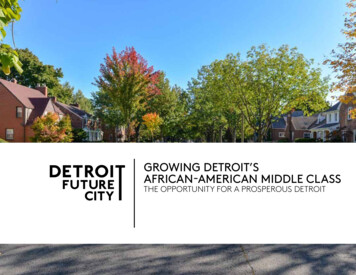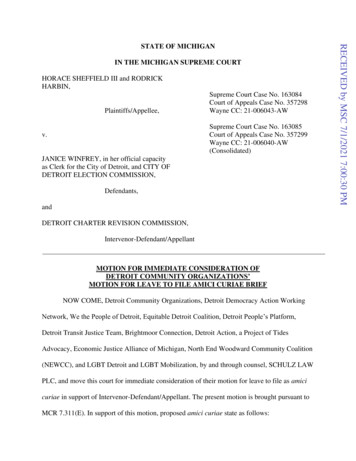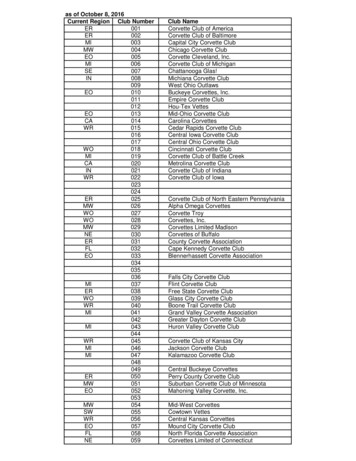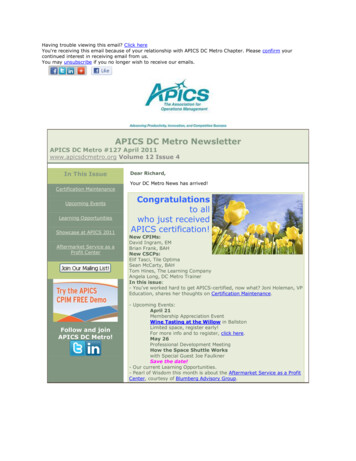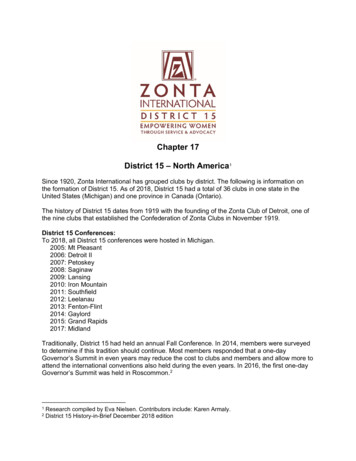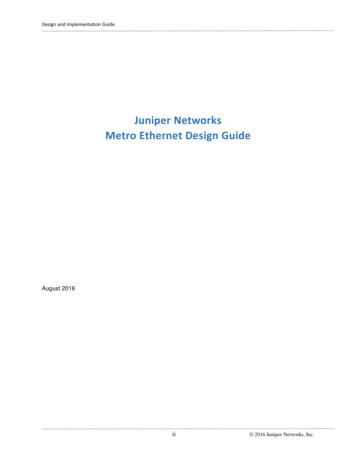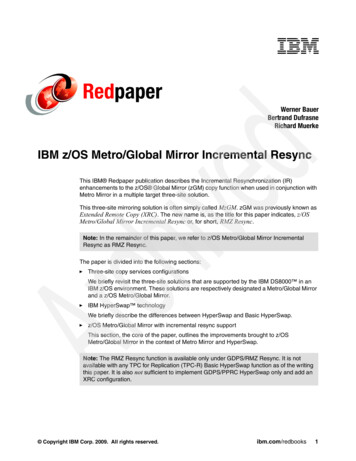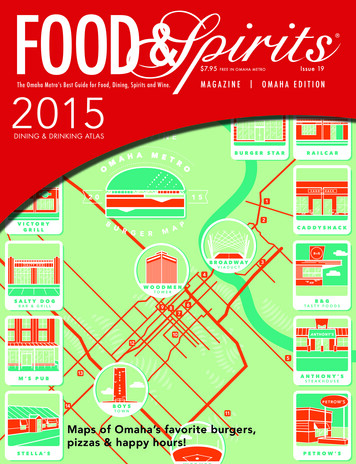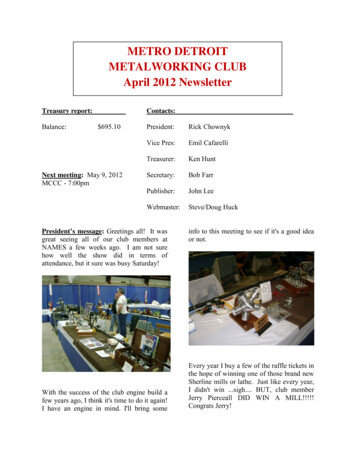
Transcription
METRO DETROITMETALWORKING CLUBApril 2012 NewsletterTreasury report:Balance:Contacts: 695.10Next meeting: May 9, 2012MCCC - 7:00pmPresident:Rick ChownykVice Pres:Emil CafarelliTreasurer:Ken HuntSecretary:Bob FarrPublisher:John LeeWebmaster:Steve/Doug HuckPresident’s message: Greetings all! It wasgreat seeing all of our club members atNAMES a few weeks ago. I am not surehow well the show did in terms ofattendance, but it sure was busy Saturday!With the success of the club engine build afew years ago, I think it's time to do it again!I have an engine in mind. I'll bring someinfo to this meeting to see if it's a good ideaor not.Every year I buy a few of the raffle tickets inthe hope of winning one of those brand newSherline mills or lathe. Just like every year,I didn't win .sigh. BUT, club memberJerry Pierceall DID WIN A MILL!!!!!Congrats Jerry!
So we will need: brass and bronze, castingpatterns of a cannon, and a wooden carriagefor it.It will NOT shoot a projectile, but will be aloud noise maker. I guess we will have todiscuss the more details at the meeting. Noreal program, so don't forget your "show andtells".Hope to see ‘ya at the meeting! RickI also have another idea for a great project(ok, at least I think it's a good project). Iwould like to collect as much scrap brassand bronze as we can over the next threemeetings. Then we will figure out howmuch we have to cast a CANNON! So wewill need: brass and bronze, casting patternsof a cannon, and a wooden carriage for it. Itwill NOT shoot a projectile, but will be aloud noise maker. I guess we will have todiscuss the more details at the meeting.I also have another idea for a great project(ok, at least I think it's a good project). Iwould like to collect as much scrap brassand bronze as we can over the next threemeetings. Then we will figure out howmuch we have to cast a CANNON!Guest: Robert Kruger was a visitor to ourmeeting. Please introduce yourself at theMay meeting if you did not get a chance tomeet him in April.Show-and-Tell: In the March 2012 MDMCnewsletter Rick Chownyk shared with ussome stories, one of which briefly touchedupon a recent visit with his friend RichardHanley, who is a member of the PortlandMachinist’s Guild.This month Rickbrought some of Richard’s work to share:If you look carefully at the previous picture,you see what appears to be conflictingdovetails. However, the puzzle is capable ofbeing manipulated to separate the blocks:
Another of Richard’s puzzles works on thesame principle but in wood. It was difficultto capture the conflicting nature of thedovetail angles because the camera lensdistorts perspective at such close focus, but“in-hand” it does not look like the puzzlecan be disassembled:Thanks to Rick for sharing Richard’s workwith us. It’s nice to see the work of talentedmachinists from outside our area andhopefully Mr. Hanley will be able to visitour club meeting in person someday.Adam Hermann showed up with a set ofgears he cut himself for a new engineproject. I failed to get any info about theidentity of the engine itself, but the gearswere beautifully done:Karl Gross has made significant progress onan engine which was cast to commemoratethe 2011 GEARS show in Portland, Oregon:The base reads “GEARS 2011” and themajor components are cast in bronze (it wasquite hefty, there’s no chance of this onewalking across the table). The engine wasrunning very smoothly at the meeting. Nicework Karl! Here is a view of the reverseside:
George Waterman shared two projectswhich he did for his wife. The first is aDelrin handle for a cheese grater:George does not take these planning of theseprojects lightly, evidenced by the carefullydeveloped CAD drawings:Here is a detail picture of the handle whichshows the countersunk stainless hardware:George also rehabilitated a food processorwith a new knob:The screws are hidden and the knob rotates:I had an enjoyable conversation with Georgeabout his next project. It is a heat/Sterlingengine of complex design. George is anengineer in thermodynamics and I mustconfess that his description of the operatingmechanisms at work in his engine quicklywent over my head. However, I lookforward to learning more from George and Iencourage other members to ask about hisproject. Perhaps we can entice him intogiving a presentation on thermodynamicsand heat engines at a future meeting.
Brian Lawson brought along a mylar loop ofold “Bo-Dot” CNC tape:This was apparently one of the first “codedprogram” methods used in productionmachining. The tape is tractor fed in a loopand the instructions are read from the patternof holes in the tape, like a player piano:pattern, milled by Steve in hard maple, willbe used by Rick Chownyk to cast workpieces during his casting demonstration atthe upcoming NAMES show:Presentation: Dr. Michael Jostock, DDSpresented an interesting lecture on aspects ofhis dental practice which dealt withmaterials, tools and procedures of interest toour members.He first brought to our attention a materialcalled Valplast. It is a two-part nylon resinused to construct partials for missing teeth:Ron Peters shared the latest progress on theheads for his second (or is it third?) V8project. Unfortunately, I neglected to get apicture of the head. Suffice it to say thatwas up to Ron’s usual very high standard ofworkmanship!Earlier pictures of thisproject can be found in the February 2012MDMC newsletter.Steve Huck continues to march forward withhis V8 supercharger project. This mapleValplast’s advantage over traditionalmaterial in this application is that it isflexible yet indestructible. That increases
comfort and durability. It is not knownwhether the product is available on a retailbasis for use in other applications (perhapsfor holding odd-shaped or soft objects formachining, or as an emergency ‘patch’alternative to JB Weld), but you can checkwith the company at its web site:www.valplast.comJust as in any machinist’s shop, manydevelopments in Mike’s practice have comeabout by adapting to emergencies andunique situations which walk through thedoor. In one such instance, Mike had ayoung patient with a tooth that had brokenbelow the gum line. The root was still intactso Mike was reluctant to put the childthrough the trauma of an extraction.Instead, Mike relied upon an orthodonticprocess called “distraction osteogenesis.” Inthe simplest terms, he screwed a small eyebolt into the remaining tooth, created atemporary bridge across the gap to theadjacent teeth, and then (over a short period)used tension between the eye bolt and thebridge to draw the broken tooth above thechild’s gum line. Moving the broken toothupward is the “distraction” portion of theprocedure, which means ‘to draw apart.’Because Mike did not fully extract thebroken tooth, the root and the bone of thejaw grew in a path which followed the toothupward. That phenomenon is the source ofthe “osteo” (bone) and “genesis” (creation)portions of the procedure.The mound of new bone below the tooth leftthe patient with a stronger foundation thanwould have been available if it had beenextracted and a traditional bridge made.Mike used the remaining tooth and newbone to install a permanent threadedtitanium anchor pin called a Camlog. Apackaged one is pictured here:Mike’s young patient is now in his 40’s andis still relying on that tooth!Here is a diagram showing the individualcomponents of a Camlog insert, whichutilizes several concentric-threaded boresand precision machined abutments:
The company has an interesting web sitewhich can be viewed a www.camlogus.com.Multiple Camlogs can be combined to holda larger removable multi-tooth denture:Mike also brought along his own clearacrylic models to show the hardware:The pictures on this page were borrowedfrom Camlog’s site. The posts are versatile,for single or multi-tooth applications:The diagrams from the Camlog site showposts sticking out above the gum line, whichseems like it would be awkward when the
dentures were not attached. Mike’s modelsinstead showed a flush post (here theinternal hex drive can barely be seen):An application of CNC developments to thedental field which Mike brought to ourattention is the manufacture of crowns froma material called ‘cubic zirconia’ (CZ)instead of from gold or solid porcelain.Blocks of CZ are very dense and resistent tofracture. Replacement tooth cores are 3DCNC milled from blocks of CZ:The flush posts in the jaw correspond withsimilar posts in the denture, which snappedtogether with a secure ‘click’ and seem tohold very securely:The teeth are then baked at about 2,500degrees to bond ceramic porcelain to the CZsurface. The porcelain coating can becustom tinted so that partials blend to theexisting teeth better:The system works for securing either upperor lower dental restorations. The Camlogsystem was an interesting application ofprecision metal working to help advancedentistry.
Precision machined titanium Camlog postsand 3D-CNC machined cubic zirconiareplacement teeth certainly represent aspectsof the dental industry which have benefitedfrom developments pioneered in the metalworking trades. However, Mike’s personalhobby interests in metal working recentlyhelped him to identify the followingsolution to a particularly difficult part ofinstalling the Camlog posts:The jaw contains nerve pathways (calledsinuses) within the bone:3D-iCAD imaging can be thought of as thex-ray/imaging equivalent of 3D coordinatemeasuring systems. However, the electronicimaging “probe” can map the internalcontours of the nerve sinuses in a way that amechanical CMM probe never could:Camlog implants are screwed directly intothe jaw bone, which means that there issome risk of cutting those nerves (withpainful and debilitating consequences). Amedical imaging process called 3D-iCATscanning has helped improve identificationof the position of those nerve sinuses inrelation to the planned implants:More info about the 3D-iCAT system isavailable at www.imagingsciences.comIt is an interesting system in its own right.
However, even with improved mapping ofnerve sinuses provided by 3D imaging, therisk of nerve damage remains compoundedby the fact that drilling the hole is stillperformed freehand:The threat to the nerves imposed by evencareful freehand drilling is where Dr. Mike’smetalworking hobby and dental medicineknowledge met to form a solution.Mike’s metal working interests hadintroduced him to 3D printing / additivemanufacturing technologies. In 3D printing,coordinates are used to build-up (rather thanmachine away) material to create a faithfulreplica of an object including its internalfeatures. The later capability is key: 3Dprinting, just like 3D-iCAD imaging, iscapable of measuring and replicating smalland intricate internal features where CMMprobes cannot reach and where machiningfrom solid material is simply impossible. Inthis application, Mike used a 3D-iCAT scanof his patient’s jaw (which already includesthe coordinates of the nerve sinuses withinthe bone) as the source of coordinate codesto drive a 3D printer to manufacture a clearacrylic replica of his patient’s jaw (imaginethese pins removed at this stage):That replica of the patient’s jaw includes theteeth, jaw bone and internal nerve sinuses,accurately located in three dimensions towithin 0.3mm. Mike can then use that clearmodel jaw to drill the holes needed for themetal implant screws. This is done on themodel, outside of the patient’s mouth, in anaccurately controlled drill press and with aclear view of the inside of the model jaw(through the clear acrylic) showing preciselywhere the nerve sinuses are.Mike then inserts temporary metal guidepins in the holes drilled into the model jaw(shown in the previous picture) and metalbushings over those pins. He then molds areversed secondary acrylic fixture to themodel jaw which captures the metalbushings but not the guide pins. Thefollowing picture is a loose-fittingreassembly of those parts: the temporaryguide pins hold the bushing in place while
the acrylic upper fixture cures to a hardenedcondition around those bushings and thesurrounding teeth:The 3D i-CAD model jaw represents thepatient’s own jaw, the pins have been drilledin that model in a precisely controlledmanner to avoid the nerve sinuses (i.e., nomore freehand drilling on the patient, or onthe model for that matter), and the metalbushings are accurately located in thereversed secondary fixture by a positiveconnection to those temporary pins and thepatient’s existing teeth.This means that the cured/hardenedreversed secondary fixture containing thebushings is now an accurate drilling jigwhich can be snapped onto the patient’s ownjaw. This drilling jig will then help to guidethe drill (previously represented by thetemporary guide pins) in a path which wasaccurately established in advance against thepatient’s own 3D-iCad and 3D-printerreplica jaw to avoid the internal nerves:Mike’s creative combination of 3D imagingand 3D printing to overcome the risks offreehand dental drilling (that phrase alonemakes me shiver!) highlights the endlesspotential for CNC technology. This is animpressive step forward from the mylar tape“Bo-Dot” program shared by Brian Lawson.What an interesting contrast to have bothsystems at one meeting!Rick Chownyck has said before that whenhe is approached at shows about his Rick-OMatic and asked “what can CNC do?” heoften responds “what do you want it to do?”Mike’s drilling fixture is an excellentapplication of Rick’s observation.Well done Mike, and thank you for givingthis very interesting presentation!-Bob Farr, Secretary
Camlog implants are screwed directly into the jaw bone, which means that there is some risk of cutting those nerves (with painful and debilitating consequences). A medical imaging process called 3D-iCAT scanning has helped improve identification of the positionof those nerve sinuses in relation to the planned implants:
